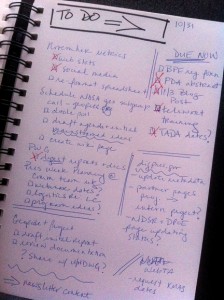I like lists. I particularly like ordered lists. I’ve even read a book about checklists. Which is one of the reasons I wanted to point out a recent OCLC report, You’ve Got to Walk Before You Can Run: First Steps for Managing Born-Digital Content Received on Physical Media(PDF).
The report focuses on practical approaches institutions can apply to managing born-digital collections acquired on digital media, such as CD-ROMs, external drives and floppy disks. These approaches are laid out in a series of steps – and could be viewed by some as a checklist.
Here at the Library of Congress, the Tangible Media Project is developing generic workflows to get its digital collections off soon-to-be obsolete or at-risk physical media into storage systems for management and preservation. For those smaller to mid-sized institutions whose collections are equally at-risk, this report offers practical methods to take action now, get the boxes of physical media “off the floor” and the digital content into a stable environment (for the time being).
 Not everything in the report may be relevant to your institution’s born-digital collections, but it could be a starting point. The benefit to referencing a step-by-step approach like this one could help identify gaps an organization’s ability to manage born-digital materials. For example, if you’re unable to perform or complete any of these steps, you gain knowledge about which actions may require resources, training, and other support for your institution’s digital preservation activities.
Not everything in the report may be relevant to your institution’s born-digital collections, but it could be a starting point. The benefit to referencing a step-by-step approach like this one could help identify gaps an organization’s ability to manage born-digital materials. For example, if you’re unable to perform or complete any of these steps, you gain knowledge about which actions may require resources, training, and other support for your institution’s digital preservation activities.
OCLC also published a follow-up report, Swatting the Long Tail of Digital Media: A Call for Collaboration (PDF) intended for decision-makers to help them understand the time, money and resources that may need to be allocated to the preservation of born-digital collections. You can read more about the project supporting both reports here.
One of the topics of conversations on this blog revolves around the challenges and solutions smaller institutions face with collecting and preserving born-digital materials. How do institutions get started with digital preservation projects? What are the best practices, workflows and tools available for managing and archiving digital content? What are other institutions doing? Or, what should they be doing? There are no easy answers to these questions, but we hope to explore them here with our readers. Please let us know if there are other topics of interest we can all discuss.

